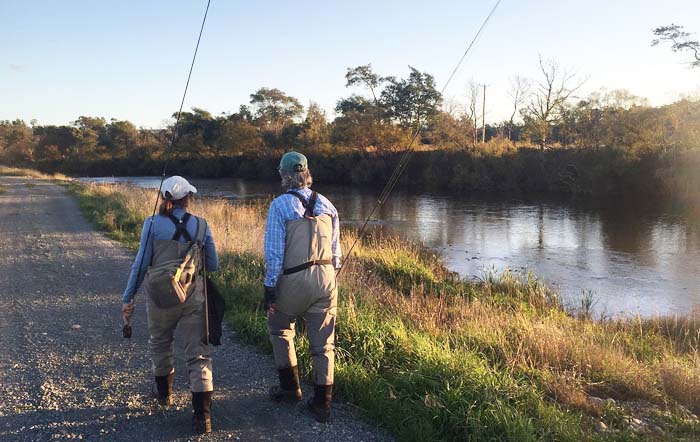
Fly fishing the Mersey River, Tasmania. Photo by Mike Cline – April 2017. A commons image.
I love this fly. It’s easy to tie, I have all the materials, and it’s been successful for 170 years
By Skip Clement
According to Tim Flagler [Tightline Productions], Wikipedia, Martin Joergensen [Global Flyfisher], Catherine Comar’s book A Graceful Rise: Women in Fly Fishing Yesterday, Today, and Tomorrow, and a random selection of a few blogs, the Red Tag fly, which I was about to write was a copy of a Royal Wulff and Adams is an ancient classic.
The fly was born in the 1850s and attributed to Martyn Flynn from Worcestershire, England. It was tied as a dry fly and meant for grayling in the North Country of England.

Salmo trutta illustration by award winning watercolorist Thom Glace. Used with permission.
For the benefit of history buffs, the original name was The Worcestershire Gem, but few people refer to it as anything other than the Red Tag these days. It is a very suitable name since the predominant red tail or tag is one of the main traits of the fly. As a fly of the 1850s and earlier, beginning with Dame Juliana Berners, A Treatyse of Fysshynge wyth an Angle [1496 – first known book on flies and fly fishing in England], tying was done with simplicity, few cheap and common materials, and all-natural.
At some point, the fly migrated to Australia’s Tasmania, where it became famous for attracting takes by brown trout and remains a fly box must today. Currently, the fly is tied with a body of peacock herl, a tail of red or crimson Antron yarn, and a red cock’s hackle for a collar [the actual color of the hackle is reddish brown]. The hackle can be hen’s hackle for wet fly versions. Hook sizes vary from #16 through #10. Ribbing was added later and served as an anchor for the Antron.
Martin Joergensen, Global Flyfisher, says the fly palmered [Red Palmer] is a go-to fly for saltwater and incredibly picky sea trout in calm, clear water. His tying is similar to that shown in Flagler’s video but decidedly beefier.
In Flagler’s version, the recipe for the Red Tag Wet Fly
Hook: Barbless, 3X-strong nymph hook [Fulling Mill FM51 05], sizes 10 to 14.
Thread: Black, 8/0, or 70-denier.
Tag: Red Antron yarn.
Rib: Gold Ultra Wire, small.
Body: 2 peacock herl.
Collar: Brown hen hackle.
Head: Tying thread.
Adhesive: Head cement.
The big question is, does the Red Tag Wet Fly catch fish?
I’d always leave home with a half dozen variations. I wonder if it’s going to start failing now?






